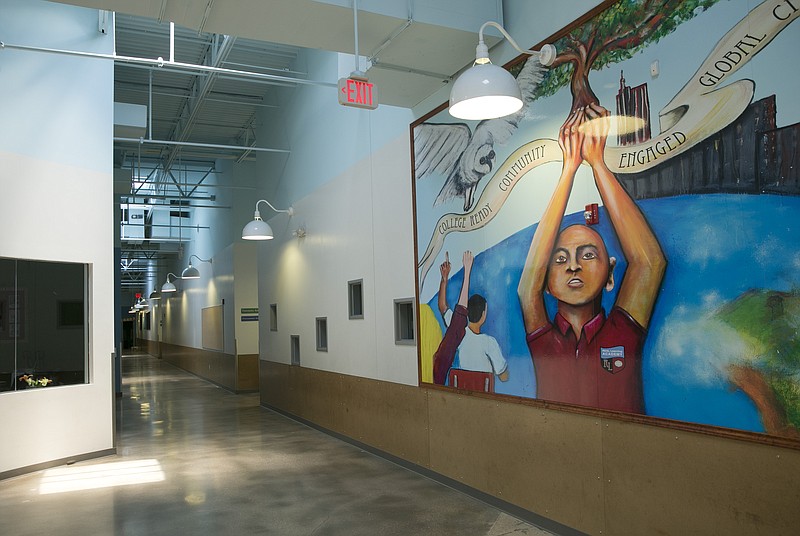AUSTIN-Tucked away in a bustling Southeast Austin shopping center, the Wayside REAL Learning Academy charter school has tried to shed its past as a Target store. A mural of a pondering child has replaced the red logo on the building's front. Brightly painted classrooms break up the once-expansive retail space.
"We are incredibly resourceful in a very limited footprint in order to provide everything that we can do, and it's largely just due to affordability," said Matt Abbott, executive director of the school.
The Austin American-Statesman reports that like Wayside, many public charter schools in Texas occupy old commercial space, in addition to old bowling alleys, churches and offices, mainly out of necessity. School officials want to build schools but lack money.
In the upcoming legislative session, charter schools, which are privately managed public schools, are expected to renew their fight for facilities funding.
"The largest inequity for charter schools is the lack of facilities funding," said David Dunn, executive director of the Texas Charter School Association. "In 2013-2014, ISDs received $5.5 billion in facilities funding. Charter schools received $0."
Unlike traditional public schools, charter schools can't levy property tax to help pay for their facilities, so they rely on fundraising and setting aside some of the state money they receive for day-to-day operations.
Because they must renew their contracts with the state after five years and don't have collateral like traditional school districts, charters also have a harder time borrowing money from banks.
Meanwhile, traditional public schools, which also face limited resources, are fighting for the same pot of money.
"You're dealing with a one-size pie. We generally don't see increases in overall educational funding," said Dax Gonzalez with the Texas Association of School Boards, which represents traditional school district boards.
Charter school enrollment has grown an average of 13 percent per year over the past 15 years. Growth has slowed slightly-from 16 percent in 2013 to an estimated 9 percent in 2016-which could be a sign that charter schools are approaching capacity.
The number of children who are on waiting lists at charter schools has ballooned from 56,000 in 2011 to 130,000 in 2015, according to the association.
Wayside, whose goal is to provide its 2,000 students an International Baccalaureate education, opened its first campus in an old church on Manchaca Road in South Austin. It expanded to a shuttered Target off Interstate 35 and East William Cannon Drive in 2012 and recently purchased land in Southeast Austin to build its first school from the ground up.
"For the longest time, our story was find a facility that we could afford, get a lease and find an owner who is willing to do a favorable return for a charitable purpose," Abbott said. "I think those days are numbered in Austin because that's just not what the market is like anymore."
Rising rent and property values in a saturated market like Austin has made it difficult for charter schools to find property. The philanthropic community is inundated with requests, so capital campaigns are difficult to pursue.
Charter schools can turn to the bond market but face higher interest rates than traditional school districts because loan companies see them as risky investments.
"Charter contracts are for five years, so that makes some banks question whether they should award a 20- or 30-year loan. Other than desks and chairs and buses, they don't have a lot that they could show as collateral," said Debbie Ratcliffe, spokeswoman for the Texas Education Agency.
In 2014, charter schools got a break-lawmakers had qualified some of them to borrow money with the backing of a portion of the $30 billion educational endowment called the Permanent School Fund. This allowed charter schools to borrow money at lower interest rates. The program's money has run out, however.
In 2015-16, charter schools also started receiving some facilities funding for new campuses, but they don't get the money until the school opens with students enrolled, and the money can't be used for repurposing a building.
Traditional school districts are required to give charter schools an opportunity to use, buy or lease a facility that a school district no longer needs.
For those reasons, Texas does better than 22 other states in how fairly they support charter facilities, according to the National Alliance for Public Charter Schools.
Jessica Johnson, head of the Colorado-based Charter School Facilities Initiative, said that Texas can still do more.
"I would think about looking at a per-pupil allocation for facilities," Smith said. "Texas charter schools are taking dollars out of the classrooms for facilities that they could be using to pay teachers, to help students with more innovative . curriculum ideas and to be able to serve their students better."
Three bills that failed last year would have increased charter schools' cut of the Permanent School Fund, exempted charter schools that lease from paying property taxes and provided per-student facilities funding.
Michelle Smith, executive director of the Fast Growth School Coalition, which supports school districts that have rapid enrollment growth, opposes providing more money for charter schools when some school districts don't get any facilities funding.
She represents 75 traditional school districts, including many in the Austin area, that don't receive facilities funding because of outdated funding formulas.
Charter schools by their nature are free from state mandates, so they can come up with new ways to educate children, including doing the most with what they get, Smith said.
"It's hard for me to support those funds going elsewhere, even if they're high-performing charters," Smith said. "There's a limited amount of funds in the state, and so I think that the state needs to focus those funds on where they're going to help property tax payers the most."

